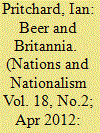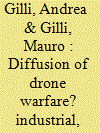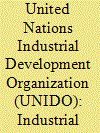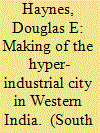|
|
|
Sort Order |
|
|
|
Items / Page
|
|
|
|
|
|
|
| Srl | Item |
| 1 |
ID:
111866


|
|
|
|
|
| Publication |
2012.
|
| Summary/Abstract |
Prior to industrialisation, there was a nebulous and fragmented Welsh national character or mass collective identity. Industrialisation engendered significant sociocultural upheaval and change, and for this 'new' society to function effectively a cohesive Welsh identity had to emerge. Because the impetus behind industrialisation had occurred primarily in a British context, any newly formed Welsh identity would ultimately have to be reconciled to the nation's industrial import within a 'United Kingdom'. Mass cultural commonalities and the role played by leisure in this procedure is a core element in the establishment of industrial modernist nation-states. Therefore, this article argues that public-house culture played a central role in the construction of a new industrial Welsh national ideology that was ultimately allied to, and a constituent of, a British imperial agenda designed to exploit both the natural resources and workforce of the area to its maximum extent.
|
|
|
|
|
|
|
|
|
|
|
|
|
|
|
|
| 2 |
ID:
147903


|
|
|
|
|
| Summary/Abstract |
Many scholars and policymakers are concerned that the emergence of drone warfare—a first step toward the robotics age—will promote instability and conflict at the international level. This view depends on the widely shared assumption among International Relations scholars that military hardware spreads easily, especially in the age of globalization and real-time communications. In this article, we question this consensus. Drawing from the literature in management, we advance a new theory of diffusion of military innovations and test its two underlying causal mechanisms. First, we argue that designing, developing, and manufacturing advanced weapon systems require laboratories, and testing and production facilities, as well as know-how and experience that cannot be easily borrowed from other fields. Second, we argue that the adoption of military innovations requires both organizational and infrastructural support. We test our two claims on three types of combat-effective drones: loitering attack munitions (LAMs), intelligence surveillance and reconnaissance drones (ISR), and unmanned combat autonomous vehicles (UCAVs). We find that even wealthy, advanced, and militarily capable countries such as the United States, the United Kingdom, Germany, and France have struggled to produce or adopt such platforms. We conclude that concerns about the diffusion of drone warfare appear significantly exaggerated, as do claims that globalization redistributes military power at the global level. More generally, our analysis sheds light on how the interaction between platform and adoption challenges affects the rate and speed of diffusion of different military innovations.
|
|
|
|
|
|
|
|
|
|
|
|
|
|
|
|
| 3 |
ID:
032217


|
|
|
|
|
| Publication |
New York, United Nations, 1969.
|
| Description |
48p
|
| Series |
United Nations Publication
|
|
|
|
|
|
|
|
|
|
|
|
Copies: C:1/I:0,R:0,Q:0
Circulation
| Accession# | Call# | Current Location | Status | Policy | Location |
| 003919 | 607.205/UNI 003919 | Main | On Shelf | General | |
|
|
|
|
| 4 |
ID:
123065


|
|
|
|
|
| Publication |
2013.
|
| Summary/Abstract |
This essay explores the rapid expansion of small handloom centres in Western India between 1930 and 1970. It attributes the transformation of these places into larger cities to the role of local weaver-capitalists, who developed new markets for local textiles and introduced significant technological innovations into the industry, and who forged strategies for combatting the growth of labour resistance. The essay also highlights the role of the late colonial and early post-Independence states, which promoted the growth of weavers' co-operatives and which imposed extensive regulations on larger enterprises. The paper argues that the powerloom centres of Western India sustained a 'hyper-industrial' quality, with limited economic or cultural diversification, restricted urban amenities and public services, and the extensive concentration of poor urban migrants in slums.
|
|
|
|
|
|
|
|
|
|
|
|
|
|
|
|
|
|
|
|
|